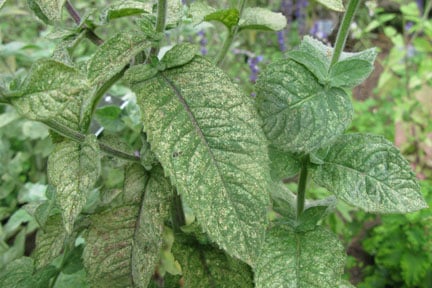
Quick facts
Common names - Sage and Ligurian leafhoppers
Scientific names - Eupteryx melissae and E. decemnotata
Plants affected - Many aromatic plants in the Lamiaceae family, including sage, mints, lavender, bergamot, marjoram, oregano, rosemary, basil, thyme and lemon balm
Main symptoms - Coarse pale spotting on upper leaf surface. Leafhoppers may be seen on the underside of leaves
Most active - April to September
What are sage and Ligurian leafhoppers?
The leafhoppers are a family (Cicadellidae) of sucking true bugs, there are more than 180 species found in Britain. They can jump or fly short distances and most do not feed on or cause noticeable damage to garden plants. Find out more about British species from British bugs.
Sage and Ligurian leafhoppers are similar in appearance, they suck sap from aromatic plants in the Lamiaceae family, including sage, mints, lavender, bergamot, marjoram, oregano, rosemary, basil, thyme, and lemon balm. Their feeding causes a course pale mottling of the foliage. These leafhoppers are widespread in the UK. The adults are up to 3.5 mm long, pale green and heavily dappled with brown and black markings. The adult insects are broadest at the head end and sit with their wings folded back over their bodies. When disturbed, they readily jump and can fly short distances. The nymphs are creamy white in colour and do not have fully formed wings. As leafhopper nymphs grow they shed their skins several times. The discarded white skins can often remain attached to the lower leaf surface and are sometimes referred to as ‘ghost insects’.
These leafhoppers overwinter as eggs on host plants and are active from May until the autumn.
Symptoms
Sage and Ligurian leafhoppers cause a pale mottling on upper leaf surfaces of host plants. By late summer affected leaves may be heavily mottled, although this seems to have little effect on plant growth.
Management
Sage and Ligurian leafhoppers are part of the healthy host plants support, and so control is not necessary. Affected herbs are safe to eat.
- Often leafhoppers do not affect the growth or vigour of plants and so can be tolerated
- Encourage predators and other natural enemies of leafhoppers, in the garden, such as birds, ladybirds, wasps and ground beetles






